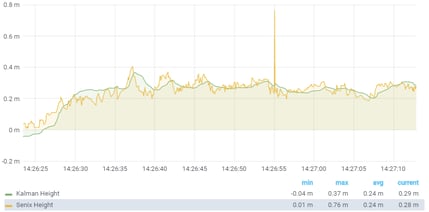Earlier this year, Xsens technology contributed to the brand new boat the TU Delft Solar Boat Team built. In this blog, team member Nerine Usman tells you all about her experiences!
Xsens and the TU Delft Solar Boat Team
With a team consisting of 24 enthusiastic, motivated students, we designed, built, tested and raced with the boat. The boat has hydrofoils, which can lift the hull out of the water. Together with Thomas van der Pas I worked on the height control of our boat.
Our boat had only two hydrofoils, one front and one rear foil. To keep the boat stable, the pilot steers with the front strut. You can think of this as if the boat was a bike. When you heel a bit over to one side, you steer in that direction to make the wings come back straight under the boat. The angle of the wings could be controled by small motors which were attached to the wings. In the front this motor was ‘simply’ placed on top of the strut, inside the hull. But in the back, there wasn’t enough space, since the electric main motor was already placed there. So the small motor for the wing pitch had to be attached to the wing by the use of a push-pull cable.
In our first tests and in a race event early in the year, we had the rear wing in a fixed position and controlled the height only by our front wing. This was to test the height control loop step by step. We did not want the two outputs on both wings to interfere with one another. The first control loop we used was a proportional control on the height. We set the angle of attack of the wing to be 15 times the error in height in m, which is the desired height minus the measured height. The angle of attack however, isn’t necessarily the angle of the wing compared to the boat. It changes significantly when the pitch of the boat changes. So the pitch of the boat had to be deducted of the desired angle of attack to determine what angle the wing had to be moved to.
For this controlloop, we needed two accurate measurements; one of the height of the boat and one of the pitch. On board we had an ultra sonic sound sensor from Senix and the MTi-G-710 from Xsens. The pitch of the boat could easily be deduced from the measurements provided by the Xsens technology. The height measurements from the Senix included a lot of errors, which we did not want to take into account. Sometimes, the Senix missis one of the sound pulses which makes it think that the next pulse it receives took twice as long to go back and forth, so the measurement ends up twice as high. Secondly the water surface is not as flat as a mirror, but contains waves, so all the measurements are fluctuating, even when the boat is at a constant height. To rule out most of these measurement inconsistencies, I made a Kalman filter, which also used the accelerations, measured by the Xsens MTi-G-710 in the vertical direction. In the picture below, you can see some measurements during a race when the boat starts to fly. The direct measurements from the Senix are in yellow and the estimations for the actual height using the Kalman filter are in green. They are probably still not perfect but a lot more realistic and smoother and therefore easier to work with than the original measurements. It could also be very dangerous if the wings suddenly would react to an outlier, as we see in the measurements from the Senix on 14:26:55. 
Later, we added dependencies of the measurements and control loop on the velocity and the roll of the boat, and for this we used the Xsens measurements too. Every small addition to the control loop or measurements used, could lead to great differences in the performance of the boat. This meant that every new addition led to a lot of time needed for testing. In the end, not everything we wanted to do could be realised. I can imagine that knowing the exact rotation and accelerations in every direction can be of even greater value in future development.
It was very pleasant to work with the MTi-G-710, since it was very reliable. A lot of elements on the boat have had their breakdowns, but the Xsens technology has always worked and its measurements were very accurate and calculated frequently.
We participated in the Solar Sport One competition and in the end achieved a beautiful second place. Thank you for your support and making it possible for us to work with Xsens!